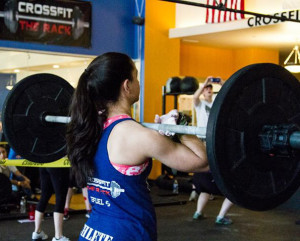Improving health-related fitness in adolescents: the CrossFit Teens™ randomised controlled trial. (*Study)
 The CrossFit Teens program was studied at the high-school level in Australia, to evaluate the practicality and effectiveness of using it for the improvement of health-related fitness and resistance training skill competancy. The results over eight weeks were favorable changes in body mass index, flexibility, cardiorespiratory ability, and muscular fitness. The abstract for the study is below, but for anyone who’s seen the program at work, its effectiveness can’t be denied. We’d also like to add that very few adults remember their gym class as producing positive body composition changes along with cardiovascular and muscular adaptations.
The CrossFit Teens program was studied at the high-school level in Australia, to evaluate the practicality and effectiveness of using it for the improvement of health-related fitness and resistance training skill competancy. The results over eight weeks were favorable changes in body mass index, flexibility, cardiorespiratory ability, and muscular fitness. The abstract for the study is below, but for anyone who’s seen the program at work, its effectiveness can’t be denied. We’d also like to add that very few adults remember their gym class as producing positive body composition changes along with cardiovascular and muscular adaptations.
Here’s the abstract – but honestly, most people (parents and teens alike) would be far better served by seeing the program in action for eight weeks at their local high-school.
J Sports Sci. 2015 May 14:1-15. [Epub ahead of print]
Improving health-related fitness in adolescents: the CrossFit Teens™ randomised controlled trial.
Eather N, Morgan PJ, Lubans DR.Abstract
The aim of this study was to evaluate the preliminary efficacy and feasibility of the CrossFit Teens™ resistance training programme for improving health-related fitness and resistance training skill competency in adolescents. This assessor-blinded randomised controlled trial was conducted in one secondary school in the Hunter Region, Australia, from July to September 2013. Ninety-six (96) students (age = 15.4 (.5) years, 51.5% female) were randomised into intervention (n = 51) or control (n = 45) conditions for 8-weeks (60 min twice per week). Waist circumference, body mass index (BMI), BMI-Z score (primary outcomes), cardiorespiratory fitness (shuttle run test), muscular fitness (standing jump, push-up, handgrip, curl-up test), flexibility (sit and reach) and resistance training skill competency were measured at baseline and immediate post-intervention. Feasibility measures of recruitment, retention, adherence and satisfaction were assessed. Significant group-by-time intervention effects were found for waist circumference [-3.1 cm, P < 0.001], BMI [-1.38 kg · m‒2, P < 0.001], BMI-Z [-0.5 z-scores, P < 0.001], sit and reach [+3.0 cm, P < 0.001], standing jump [+0.1 m, P = 0.021] and shuttle run [+10.3 laps, P = 0.019]. Retention rate was 82.3%. All programme sessions were delivered and participants’ mean satisfaction scores ranged from 4.2 to 4.6 out of 5. The findings demonstrate that CrossFit Teens™ is a feasible and efficacious programme for improving health-related fitness in adolescents.
*Statements made on www.3fu3l.com do not represent affiliation or endorsement by or with CrossFit.


